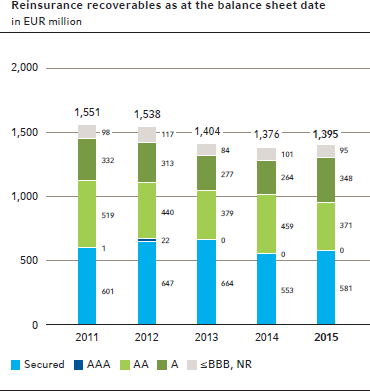Counterparty default risks
The counterparty default risk consists primarily of the risk of complete or partial failure of the counterparty and the associated default on payment. The required risk capital for counterparty defaults with the confidence level of 99.5% amounted to EUR 279.9 million as at 30 September 2015.
Since the business that we accept is not always fully retained, but instead portions are Retroceded as necessary, the credit risk is also material for our company in reinsurance transactions. Our Retrocession partners are carefully selected and monitored in light of credit considerations in order to keep the risk as small as possible. This is also true of our broker relationships, which entail a risk inter alia through the potential loss of the premium paid by the cedant to the broker. We minimise these risks, among other things, by reviewing all broker relationships once a year with an eye to criteria such as the existence of professional indemnity insurance, payment performance and proper contract implementation. The credit status of retrocessionaires is continuously monitored. On the basis of this ongoing monitoring a Security Committee decides on measures where necessary to secure receivables that appear to be at risk of default. This process is supported by a Web-based risk management application, which specifies cession limits for the individual retrocessionaires participating in protection cover programmes and determines the capacities still available for short-, medium- and long-term business. Depending on the type and expected run-off duration of the reinsured business, the selection of reinsurers takes into account not only the minimum ratings of the rating agencies Standard & Poor’s and A.M. Best but also internal and external expert assessments (e. g. market information from brokers). Overall, retrocessions conserve our capital, stabilise and optimise our results and enable us to act on opportunities across a broader front, e. g. following a major loss event. Regular visits to our retrocessionaires give us a reliable overview of the market and put us in a position to respond quickly to capacity changes. The following table shows how the proportion of assumed risks that we do not retrocede (i. e. that we run in our retention) has changed in recent years:
| Gross written premium retained | |||||
| in % | 2015 | 2014 | 2013 | 2012 | 2011 |
|---|---|---|---|---|---|
| Hannover Re Group | 87.0 | 87.6 | 89.0 | 89.8 | 91.2 |
| Property and casualty reinsurance | 89.3 | 90.6 | 89.9 | 90.2 | 91.3 |
| Life and health reinsurance | 84.2 | 83.9 | 87.7 | 89.3 | 91.0 |
Alongside traditional retrocessions in property and casualty reinsurance we also transfer risks to the capital market.
Counterparty default risks are also relevant to our investments and in life and health reinsurance because we prefinance acquisition costs for our ceding companies. Our clients, retrocessionaires and broker relationships as well as our investments are therefore carefully evaluated and limited in light of credit considerations and are constantly monitored and controlled within the scope of our system of limits and thresholds.
The key ratios for managing the counterparty default risk are as follows:
- 88.5% of our retrocessionaires have an investment grade rating (“AAA” to “BBB”).
- 88.3% are rated “A” or better.
- 41.7% of our recoverables from reinsurance business are secured by deposits or letters of credit. What is more, for the majority of our retrocessionaires we also function as reinsurer, meaning that in most cases recoverables can potentially be set off against our own liabilities.
- In terms of the Hannover Re Group’s major companies, EUR 236.4 million (6.4%) of our accounts receivable from reinsurance business totalling EUR 3,665.9 million were older than 90 days as at the balance sheet date.
- The average default rate over the past four years was 0.4%.
Retrocession gives rise to claims that we hold against our retrocessionaires. These reinsurance recoverables – i. e. the reinsurance recoverables on unpaid claims – amounted to EUR 1,395.3 million (EUR 1,376.4 million) as at the balance sheet date.

The following chart shows the development of our reinsurance recoverables – split by rating quality – due from our retrocessionaires.
Further remarks on technical and other assets which were unadjusted but considered overdue as at the balance sheet date as well as on significant impairments in the year under review are provided in Section 6.4“Technical assets”, Section 6.6 “Other assets” and Section 7.2 “Investment result”
More Information
Topic related links within the report:


